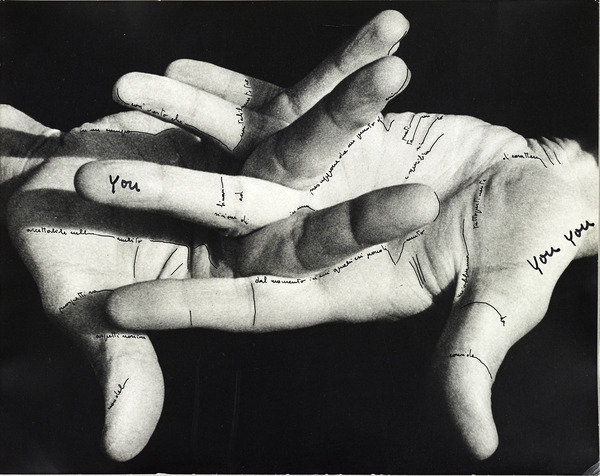Ketty La Rocca
dal 29/4/2014 al 23/5/2014
Segnalato da
29/4/2014
Ketty La Rocca
Galerie Kadel Willborn, Dusseldorf
The film 'Appendice per una Supplica' and the attendant series of photographed hands reveal her attempt at developing a language that is not pre-coded by society.

Ketty La Rocca (1938-1976) ranked among the most important proponents of Conceptual and Body Art in Italy in
the 1960s and 70s. Despite, or perhaps because of her early death in 1976, Ketty La Rocca created an oeuvre in
just ten years, whose relevance to contemporary art is undisputed. The exhibition at Kadel Willborn in Düsseldorf
features key pieces of Ketty La Rocca’s oeuvre, some of which have never been shown in Germany.
Based on a visual poetry, she radically dealt with the socio-political limits of the meaning of language and images in
her collages, performances and photographs. A central aspect is the examination of the bodily gesture as an “original
means of communication”. Her works are included in, among others, renowned collections such as the Museum of
Contemporary Art in Los Angeles, Museum Ostwall in Dortmund, ZKM Karlsruhe or the Galleria degli Uffizi in Florence.
Already during her lifetime and until this day, her works have been on view at institutions such as the Biennale di
Venezia (1972), the Camden Arts Centre London (1972), Museum am Ostwall, Dortmund (1974), Fotomuseum
Winterthur (1987), Galerie im Taxispalais Innsbruck (2003), MoMA/PS1 New York (2007) or the Albertina in Vienna
(2012).
A central work in the presentation at Kadel Willborn is her film “Appendice per una Supplica” (Appendix for a Petition),
which was screened at the Biennale di Venezia in 1972: It shows a pair of male and female hands against a black
background gesticulating an entire repertoire of possible meanings and interpersonal tensions. The film and the
attendant series of photographed hands, “Le mie parole e tu” (My Words and You), reveal La Rocca’s attempt at
developing a language that is not pre-coded by society. This dealing with the social construction of meaning was
influenced by her work for Italian television, where she created and presented shows for deaf-mute persons. In one of
her most important performances, also entitled “Le mie parole e tu” from 1975, she reads a text that is
grammatically perfect, albeit without content. The text becomes physically present in space through the spoken
language. As a kind of “punctuation”, La Rocca repeatedly says the word “you”, which is taken up by the audience as
a refrain. The definition of the border between the self and the other as “you” is central to La Rocca’s work.
Handwriting also including the word “you” can be found in the photos of gesticulating hands from the eponymous
series. In this sense, the identity of the other is “inscribed” in one’s own actions.
La Rocca’s typographical sculptures from the late 1960s, the “I” and “Virgole e Punti” (Commas and Periods),
transfer this play of identity as “sculptural punctuation” to the real exhibition space. The capital “I” factually
positions a “self” whose reference to the surroundings can be interpreted in an open way due to the comma set
behind it and the three periods. Ketty La Rocca continues her work on gesture and meaning in her large group of
works entitled “Riduzioni” (Reductions). Everyday photographs such as film posters, tourist attractions, politicians or
family photos are serially expanded in graphic and handwritten variations. Contours are drawn by hand with the word
“you” or her “Nonsense Text” from 1970, all the way to the radical graphic schematisation of the original photograph.
Seriality and schematisation, typical features of 1960s Conceptual Art, become a means to express her subjective
view and at the same time to integrate the gaze from the outside. La Rocca’s examination of the borders between
outside and inside, looking and being looked at, finds expression in an especially captivating way in her last series,
the “Craniologie”, x-rays of her skull. Produced as a consequence of her illness, they, too, are covered with the
handwritten lettering “you”. They form an iconic self-portrait of Ketty La Rocca and are simultaneously a general
memento mori, referencing the bodily mortality of the viewing vis-à-vis. The construction of her own identity becomes
possible only in dealing with the other, or in Ketty La Rocca’s words: “The you has already started at the border of my
I.”
Special thanks to the artist’s son Michelangelo Vasta, who conceived the exhibition together with us from “Archivio
Ketty La Rocca (The Estate Ketty La Rocca).”
Kadel Willborn
The artists of Galerie Kadel Willborn (Düsseldorf) have in common the focus on recontextualising social reality. Genre-
specific borders are often crossed in a work, leading to intended shifts in perception. The young programme is
consolidated by positions from the art-historical context. The juxtaposition of different generations of artists results
in a kind of positive feedback and enables differentiated and reflected views of present-day art.
Artists of the gallery: Art & Language, Adrian Williams, Ane Mette Hol, Barbara Kasten, Benedikt Hipp, Dani Gal, Helen
Feifel, Helmut Dorner, Katja Davar, Mathilde Rosier, Matthias Bitzer, Natalie Czech, Shannon Bool, Vlassis Caniaris.
Image: "Le mie parole e tu" (Meine Worte und du / My words and you), 1973, handwriting on photograph, 24,5 x 30 cm, unique
Press contact
Dominka Szope
szope@relationales.de
Tel. 0151 16150713
Opening: Wednesday, 30 April 2014
Kadel Willborn
Iris Kadel & Moritz Willborn
Birkenstrasse 3 - 40233 Düsseldorf
Opening Times:
Mi-Fr 13 - 18
Sa 11 - 16 Uhr
or by appointment



